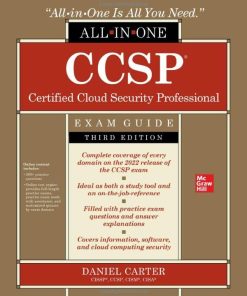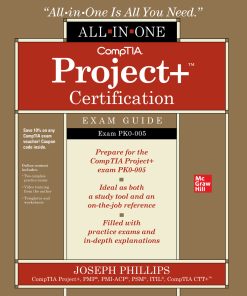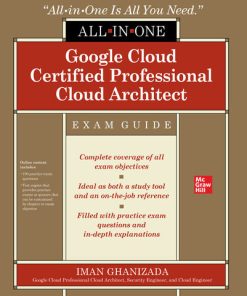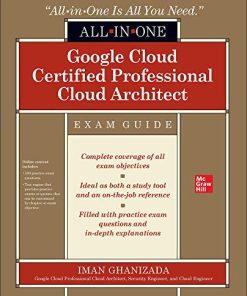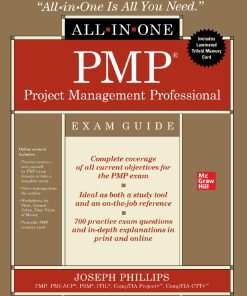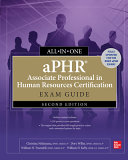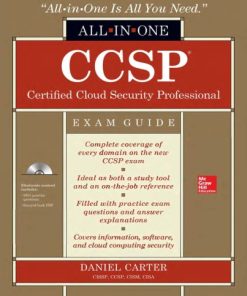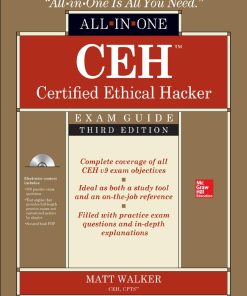(EBook PDF) PMP Project Management Professional All-in-One Exam Guide 1st edition by Joseph Phillips 1260467449 9781260467444 full chapters
$50.00 Original price was: $50.00.$25.00Current price is: $25.00.
PMP Project Management Professional All-in-One Exam Guide 1st edition by Joseph Phillips – Ebook PDF Instant Download/DeliveryISBN: 1260467449, 9781260467444
Full dowload PMP Project Management Professional All-in-One Exam Guide 1st edition after payment.
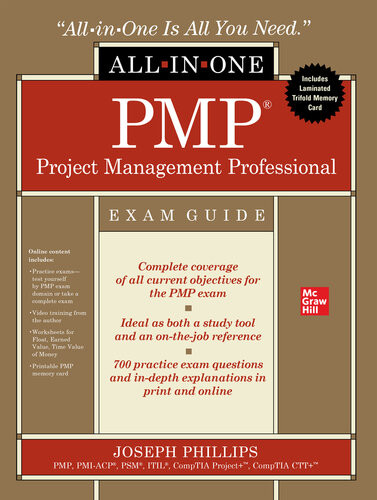
Product details:
ISBN-10 : 1260467449
ISBN-13 : 9781260467444
Author: Joseph Phillips
Complete coverage of all objectives in the 2020 release of the PMP exam—fully aligned with the PMBOK Guide®, Sixth Edition This comprehensive resource offers complete coverage of all the material included on the Project Management Professional exam. You’ll find learning objectives at the beginning of each chapter, exam tips, practice exam questions, and in-depth explanations. Written by a leading project management consultant and trainer, PMP Project Management Professional All-in-One Exam Guide will help you pass the exam with ease and will also serve as an essential on-the-job reference. Covers all exam topics, including: People Processes Business Environment Agile Best Practices Knowledge Areas Online content includes: Practice exams—test yourself by PMP exam domain or take a complete exam Video training from the author Worksheets for Float, Earned Value, Time Value of Money Printable PMP memory card
PMP Project Management Professional All-in-One Exam Guide 1st Table of contents:
Part I: Project Management Foundation
Chapter 1: Preparing for the Exam
All About the PMP Exam
Money and Your Exam
Passing the Exam
Creating Your Study Strategy
What Your Exam Is Based On
What Is a Project?
Temping a Project
Defining a Project’s Uniqueness
Changing the Organization
Creating Business Value
Progressively Elaborating a Project
Why Do Projects?
Creating Project Management Business Documents
What Is Project Management?
Back to the PMBOK Guide
Being a Project Expert
Using the Project Management Body of Knowledge
Working with Your Application Area
Examining the Project Management Context
Opening Your Portfolio
Working with Programs
Working with Subprojects
Working with Project Management Offices
Considering Projects and Operations
Identifying the Project Life Cycle
Examining a Project Life Cycle
Comparing Project Life Cycles and Product Life Cycles
Working with Project Management Processes
Exploring the Project Management Processes
Examining the Process Group Interactions
Choosing the Appropriate Processes
Working with Process Groups
Gathering Project Management Data and Information
Gathering Work Performance Data
Creating Work Performance Information
Communicating Through Work Performance Reports
Chapter Summary
Questions
Answers
Chapter 2: Managing a Project in Different Environments
Exploring Agile Project Management
Embracing the Agile Manifesto
Comparing Predictive and Agile Projects
Identifying Different Agile Approaches
Working with Enterprise Environmental Factors
Working with Internal Enterprise Environmental Factors
Considering External Enterprise Environmental Factors
Leveraging Organizational Process Assets
Adhering to Processes, Policies, and Procedures
Leveraging Organizational Knowledge Repositories
Working Within an Organizational System
Working in a System
Operating Within a Governance Framework
Identifying the Organizational Influences
Completing Projects in Different Organizational Structures
Recognizing Organizational Structures
Managing Project Teams
Working with a PMO
Chapter Summary
Case Study
Managing Projects from Start to Completion
Examining the Project Deliverables
Examining the Project Phases
Controlling Project Changes
Questions
Answers
Chapter 3: Working as a Project Manager
Exploring the Project Manager Role
Defining the Agile Project Manager
Leading the Project Team
Communicating Project Information
Negotiating Project Terms and Conditions
Active Problem-Solving
Identifying the Project Manager Influence
Influencing the Project
Influencing the Organization
Considering Social, Economic, and Environmental Project Influences
Considering International Influences
Considering Cultural and Industry Influences
Building Project Management Skills
Enhancing Skills and Competencies
Introducing the PMI Talent Triangle
Managing Politics in Projects
Serving as a Leader and Manager
Learning Leadership Styles
Creating a Leadership Persona
Performing Project Integration
Integrating Processes
Building Your Cognitive-Level Integration
Examining Context-Level Integration
Chapter Summary
Questions
Answers
Part II: Project Management Professional Knowledge Areas
Chapter 4: Managing Project Integration
Developing the Project Charter
Preparing to Create the Project Charter
Choosing a Project to Charter
Knowing the Project Management Methodology
Creating the Charter—Finally
Creating the Assumptions Log
Developing the Project Management Plan
Creating the Project Management Plan
Hosting the Project Kickoff Meeting
Directing and Managing the Project Work
Creating the Project Deliverables
Creating an Issue Log
Responding to Project Conditions
Managing Project Knowledge
Preparing to Manage Knowledge
Reviewing Knowledge Management Tools and Techniques
Reviewing the Results of Knowledge Management
Monitoring and Controlling the Project Work
Monitoring the Project
Analyzing Project Data
Creating a Work Performance Report
Managing Integrated Change Control
Reacting to Change
Using the Project Management Information System
Closing the Project or Phase
Documenting the Closing
Creating the Final Project Report
Chapter Summary
Questions
Answers
Chapter 5: Managing Project Scope
Planning the Project Scope Management
Creating the Project Scope Management Plan
Creating the Requirements Management Plan
Collecting the Project Requirements
Working with Project Stakeholders
Examining the Outputs of Requirement Collection
Defining Project and Product Scopes
Creating the Project Scope Statement
Using Product Analysis
Using Alternatives Generation
Using Stakeholder Analysis
Examining the Project Scope Statement
Planning a Sprint
Creating the Work Breakdown Structure
Using a WBS Template
Decomposing the Deliverables
Creating the WBS Dictionary
Validating the Project Scope
Preparing for Project Inspection
Inspecting the Project Work
Controlling the Project Scope
Using a Change Control System
Planning for Project Scope Changes
Approving a Change
Chapter Summary
Questions
Answers
Chapter 6: Managing Project Schedule
Planning Schedule Management
Creating the Schedule Management Plan
Examining the Schedule Management Plan
Utilizing an On-Demand Scheduling Approach
Defining the Project Activities
Making the Activity List
Examining the Activity List
Documenting the Activity Attributes
Building the Milestone List
Creating the Product Roadmap
Updating the Work Breakdown Structure
Sequencing the Project Activities
Considering the Inputs to Activity Sequencing
Creating Network Diagrams
Using the Precedence Diagramming Method
Utilizing Network Templates
Determining the Activity Dependencies
Considering Leads and Lags
Estimating Activity Durations
Considering the Activity Duration Estimate Inputs
Using Analogous Estimating
Applying Parametric Estimates
Creating a Three-Point Estimate
Estimating from the Bottom Up
Factoring in Reserve Time
Evaluating the Estimates
Predicting Duration in Agile Projects
Developing the Project Schedule
Applying Mathematical Analysis
Calculating Float in a PND
Encountering Scheduling on the PMP Exam
Applying Schedule Compression
Using a Project Simulation
Using Resource-Leveling Heuristics
Using Project Management Software
Relying on a Project Coding Structure
Considering the Outputs of Schedule Development
Reviewing the Schedule Baseline
Examining the Project Schedule
Utilizing the Schedule Management Plan
Updating the Resource Requirements
Controlling the Project Schedule
Managing the Inputs to Schedule Control
Applying Schedule Control
Measuring Project Performance
Examining the Schedule Variance
Creating Burndown and Burnup Chart
Updating the Project Schedule
Applying Corrective Action
Chapter Summary
Questions
Answers
Chapter 7: Managing Project Costs
Planning for Project Cost Management
Preparing the Cost Management Plan
Examining the Project Cost Management Plan
Preparing for Adaptive Cost Management
Determining Project Costs
Estimating the Project Costs
Creating the Cost Estimate
Examining the Cost Estimate
Budgeting the Project
Creating the Project Budget
Examining the Project Budget
Controlling Project Costs
Managing the Project Costs
Controlling Changes to Project Costs
Using Earned Value Management
Learning the Fundamentals
Finding the Project Variances
Finding the Indexes
Predicting the Project’s Future
The Five EVM Formula Rules
Chapter Summary
Questions
Answers
Chapter 8: Managing Project Quality
Planning for Quality
Using Quality Planning Tools
Creating the Quality Management Plan
Establishing Quality Metrics
Updating the Project Management Plan and Documents
Managing Quality in the Project
Preparing to Manage Quality
Managing Quality Within a Project
Completing a Quality Audit
Designing for X
Implementing Problem-Solving Techniques
Reviewing the Results of Managing Quality
Controlling Quality in a Project
Preparing to Control Quality
Relying on the Seven Basic Quality Tools
Inspecting Results
Testing Deliverables in Adaptive Projects
Creating a Flowchart
Creating a Control Chart
Creating a Pareto Diagram
Creating a Histogram
Creating a Run Chart
Creating a Scatter Diagram
Completing a Statistical Sampling
Revisiting Flowcharting
Applying Trend Analysis
Examining Control Quality Process Results
Chapter Summary
Questions
Answers
Chapter 9: Managing Project Resources
Planning for Resource Management
Identifying Organizational Approach for Managing Resources
Relying on Enterprise Environmental Factors
Using the Organizational Process Assets
Referencing the Project Management Plan
Charting the Human Resources
Networking Human Resources
Identifying Roles and Responsibilities
Creating a Project Organization Chart
Creating a Team Charter
Estimating the Activity Resources
Using Expert Judgment
Using Bottom-Up Estimating
Relying on Analogous Estimating
Utilizing Parametric Estimating
Identifying Alternatives
Relying on Published Estimating Data
Building an Agile Project Team
Examining the Activity Resource Estimates
Acquiring the Project Team
Examining the Staffing Pool
Negotiating for Resources
Working with Preassigned Staff
Procuring Staff
Managing a Virtual Team
Utilizing a Multicriteria Decision Analysis Process
Assembling the Project Team
Creating Agile Team Workspaces
Developing the Project Team
Being a Servant Leader
Preparing for Team Development
Relying on Interpersonal Management Skills
Creating Team-Building Activities
Establishing Project Ground Rules
Rewarding the Project Team
Assessing the Project Team
Managing the Project Team
Preparing for Team Management
Dealing with Team Disagreements
Creating an Issue Log
Examining the Outputs of Team Management
Relating to Organizational Theories
Maslow’s Hierarchy of Needs
Herzberg’s Theory of Motivation
McGregor’s Theory of X and Y
Ouchi’s Theory Z
Vroom’s Expectancy Theory
McClelland’s Theory of Needs
Controlling Resources
Preparing to Control Resources
Reviewing the Tools and Techniques to Control Resources
Reviewing the Results of Controlling Resources
Chapter Summary
Questions
Answers
Chapter 10: Managing Project Communications
Examining the Communications Foundation
Communication Factors
Understanding the Communications Model
Planning for Communications
Preparing for Communications
Identifying Communication Requirements
Exploring Communication Technologies
Creating the Communications Management Plan
Managing Project Communications
Examining Communication Skills
Examining Communication Factors and Technologies
Distributing Information
Creating Lessons Learned
Examining the Results of Communications Management
Monitoring Communications
Examining the Tools for Monitoring Communications
Reviewing Project Performance
Analyzing Project Variances
Examining the Results of Monitoring Communications
Chapter Summary
Questions
Answers
Chapter 11: Managing Project Risks
Planning for Risk Management
Preparing for Risk Management Planning
Completing Risk Management Planning
Creating the Risk Management Plan
Identifying the Project Risks
Finding Project Risks
Creating a Risk Register
Creating a Risk Report
Using Qualitative Risk Analysis
Preparing for Qualitative Analysis
Completing Qualitative Analysis
Applying Probability and Impact
Creating a Probability-Impact Matrix
Relying on Data Precision
Building a Hierarchical Chart
Assessing the Risk Score
Examining the Results of Qualitative Risk Analysis
Preparing for Quantitative Risk Analysis
Interviewing Stakeholders and Experts
Applying Sensitivity Analysis
Finding the Expected Monetary Value
Using a Decision Tree
Using a Project Simulation
Examining the Results of Quantitative Risk Analysis
Planning for Risk Responses
Preparing for Risk Responses
Creating Risk Responses
Managing the Positive Risk and Opportunities
Accepting the Risks
Updating the Risk Register
Creating Contracts for Risk Response
Justifying Risk Reduction
Creating a Project Contingency Response
Updating the Project Plan
Implementing Risk Responses
Preparing to Implement Risk Responses
Reviewing the Tools and Techniques for Implementing Risk Responses
Examining the Results of Implementing Risk Responses
Monitoring Project Risks
Preparing for Risk Monitoring and Control
Monitoring and Controlling Risks
Completing Risk Response Audits
Analyzing Project Variances
Measuring Technical Performance
Monitoring Contingency Reserve
Examining the Results of Risk Monitoring and Control
Chapter Summary
Questions
Answers
Chapter 12: Managing Project Procurement
Planning for Procurement
Considering Agile Agreements
Determining the Contract Type
Understanding Contract Types
Using the Procurement Planning Tools
Examining the Results of Procurement Planning
Creating the Procurement Documents
Creating Source Selection Criteria
Conducting Procurements
Hosting a Bidder Conference
Advertising for Sellers
Creating a Qualified Sellers List
Selecting a Seller
Examining Vendor Responses
Choosing the Seller
Examining the Results of Seller Selection
Controlling Project Procurements
Completing the Procurement Control Process
Reviewing the Results of Procurement Control
Performing Contract Closure
Auditing the Procurement Process
Negotiating Settlements
Completing Contract Closure
Chapter Summary
Case Study: Litke Greenhouse and Nursery Procurement Processes
Planning for Procurement
Hosting a Bidder Conference
Selecting a Vendor
Questions
Answers
Chapter 13: Managing Project Stakeholders
Identifying Project Stakeholders
Preparing for Stakeholder Identification
Launching Project Stakeholder Identification
Performing Stakeholder Analysis
Classifying Stakeholders
Finalizing Stakeholder Identification
Creating the Stakeholder Register
Planning Stakeholder Management
Preparing to Plan for Stakeholder Management
Creating the Stakeholder Engagement Plan
Examining the Stakeholder Engagement Plan
Managing Stakeholder Engagement
Preparing to Manage Stakeholder Engagement
Managing Stakeholder Relationships
Reviewing Stakeholder Engagement Results
Monitoring Stakeholder Engagement
Preparing to Monitor Stakeholder Engagement
Components of Monitoring Stakeholder Engagement
Reviewing the Outputs of Stakeholder Engagement
Chapter Summary
Questions
Answers
Part III: PMP Agile Exam Testing Areas
Chapter 14: Leading an Agile Project
Defining Agile Project Management
Reviewing the Agile Manifesto
Building the Agile Mindset
Leading an Agile Project
Exploring Agile Approaches
Diving into Scrum
Introducing Extreme Programming
Working with Other Agile Approaches
Chapter Summary
Questions
Answers
Chapter 15: Engaging Agile Stakeholders
Stakeholder Engagement in Agile Projects
Incorporating Stakeholder Values
Building Stakeholder Synergy
Leading Stakeholder Conversations
Planning for Effective Engagement
Structuring Team Stakeholder Engagement
Creating an Agile Charter
Exploring the Project Team
Creating a Team Space
Coaching the Team
Resolving Differences in an Agile Project
Chapter Summary
Questions
Answers
Chapter 16: Measuring Agile Project Performance
Defining Agile Metrics
Earned Value Management
Return on Investment
Measuring Agile Performance
Reviews and Retrospective
Understanding Velocity
Lead Time and Cycle Time
Charting Performance
Burndown and Burnup Charts
Release Burndown
Using a Control Chart in Agile Projects
Exploring Cumulative Flow Diagram
Testing in Agile Projects
Employing Acceptance Test–Driven Development
Working with Behavior-Driven Development
Exploratory Testing in Agile
Chapter Summary
Questions
Answers
Chapter 17: Managing Risks in Agile Projects
Managing Risks and Issues
Problem Detection and Resolution
Completing Variance Analysis
Working with the Risk-Adjusted Backlog
Promoting Continuous Improvement
Problem Solving in Agile Projects
Solving Scrum Problems
Solving XP Problems
Solving Problems in Lean Projects
Chapter Summary
Questions
Answers
Part IV: PMP Exam Considerations
Chapter 18: Understanding the Code of Ethics and Professional Conduct
Learning the Code of Ethics
Exploring the Code’s Vision and Purpose
Participating in the Code
Learning the Code Details
Serving Responsibly as a Project Manager
Defining Responsibility
Aspiring to Responsibility Expectations
Adhering to the Mandatory Standards of Responsibility
Adhering to the Respect Value
Aspiring to Respect
Adhering to the Mandatory Values of Respect
Being a Fair Project Manager
Aspiring to Fairness
Adhering to the Mandatory Standards on Fairness
Being an Honest Project Manager
Aspiring to Honesty
Living the Honesty Requirements
Chapter Summary
Questions
Answers
Chapter 19: Passing the PMP Exam
Tips to Pass the Exam
Prepare Before the Exam
Create Your Own Answer Key
Testing Tips
Answer Every Question—Once
Use the Process of Elimination
Everything You Must Know
The 49 Project Management Processes
Earned Value Management Formulas
Quick Project Management Facts
A Letter to You
People also search for PMP Project Management Professional All-in-One Exam Guide 1st:
pmp project management professional exam study guide pdf
pmp project management professional study guide pdf
pmp project management professional study guide mcgraw-hill
pmp project management professional practice tests pdf
pmp project management professional practice tests
You may also like…
Computers - Security
CCSP Certified Cloud Security Professional All-in-One Exam Guide 3rd Edition
Computers - Applications & Software
Computers - Networking
Computers - Networking
Google Cloud Certified Professional Cloud Architect All-in-One Exam Guide 1st Edition Iman Ghanizada
Business & Economics - Management & Leadership
PMP Project Management Professional Exam Guide 1st Edition Joseph Phillips
Uncategorized
CAPM Certified Associate in Project Management All-in-One Exam Guide 1st Edition James Lee Haner
Business & Economics - Human Resources
Computers - Computer Certification & Training
Computers - Computer Certification & Training
CEH All-in-One Exam Guide 3rd Edition Professional Matt Walker




